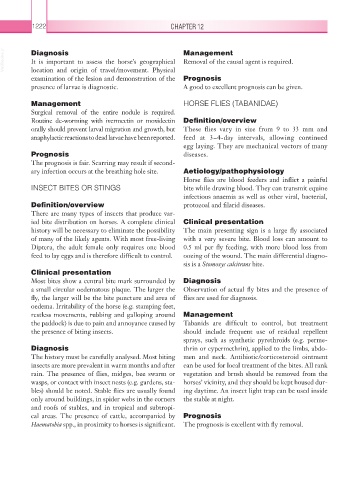Page 1247 - Equine Clinical Medicine, Surgery and Reproduction, 2nd Edition
P. 1247
1222 CHAPTER 12
VetBooks.ir Diagnosis Management
Removal of the causal agent is required.
It is important to assess the horse’s geographical
location and origin of travel/movement. Physical
examination of the lesion and demonstration of the Prognosis
presence of larvae is diagnostic. A good to excellent prognosis can be given.
Management HORSE FLIES (TABANIDAE)
Surgical removal of the entire nodule is required.
Routine de-worming with ivermectin or moxidectin Definition/overview
orally should prevent larval migration and growth, but These flies vary in size from 9 to 33 mm and
anaphylactic reactions to dead larvae have been reported. feed at 3–4-day intervals, allowing continued
egg laying. They are mechanical vectors of many
Prognosis diseases.
The prognosis is fair. Scarring may result if second-
ary infection occurs at the breathing hole site. Aetiology/pathophysiology
Horse flies are blood feeders and inflict a painful
INSECT BITES OR STINGS bite while drawing blood. They can transmit equine
infectious anaemia as well as other viral, bacterial,
Definition/overview protozoal and filarid diseases.
There are many types of insects that produce var-
ied bite distribution on horses. A complete clinical Clinical presentation
history will be necessary to eliminate the possibility The main presenting sign is a large fly associated
of many of the likely agents. With most free-living with a very severe bite. Blood loss can amount to
Diptera, the adult female only requires one blood 0.5 ml per fly feeding, with more blood loss from
feed to lay eggs and is therefore difficult to control. oozing of the wound. The main differential diagno-
sis is a Stomoxys calcitrans bite.
Clinical presentation
Most bites show a central bite mark surrounded by Diagnosis
a small circular oedematous plaque. The larger the Observation of actual fly bites and the presence of
fly, the larger will be the bite puncture and area of flies are used for diagnosis.
oedema. Irritability of the horse (e.g. stamping feet,
restless movements, rubbing and galloping around Management
the paddock) is due to pain and annoyance caused by Tabanids are difficult to control, but treatment
the presence of biting insects. should include frequent use of residual repellent
sprays, such as synthetic pyrethroids (e.g. perme-
Diagnosis thrin or cypermethrin), applied to the limbs, abdo-
The history must be carefully analysed. Most biting men and neck. Antibiotic/corticosteroid ointment
insects are more prevalent in warm months and after can be used for local treatment of the bites. All rank
rain. The presence of flies, midges, bee swarm or vegetation and brush should be removed from the
wasps, or contact with insect nests (e.g. gardens, sta- horses’ vicinity, and they should be kept housed dur-
bles) should be noted. Stable flies are usually found ing daytime. An insect light trap can be used inside
only around buildings, in spider webs in the corners the stable at night.
and roofs of stables, and in tropical and subtropi-
cal areas. The presence of cattle, accompanied by Prognosis
Haematobia spp., in proximity to horses is significant. The prognosis is excellent with fly removal.

